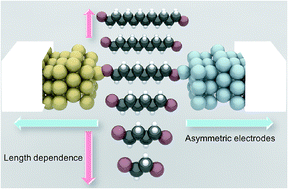Length-dependent rectification and negative differential resistance in heterometallic n-alkanedithiol junctions
Abstract
The transport properties of heterometallic n-alkanedithiol junctions have been investigated via first-principles calculations. Results show that the heterometallic n-alkanedithiol junctions exhibit significant rectification at lower voltage. A negative differential resistance was found at higher voltage, which increases with the increase of the n-alkanedithiol backbone length. In order to explain these phenomena, the molecular orbitals of n-alkanedithiol have been analyzed between certain electrodes. It is found that the rectification is induced by asymmetric orbital profiles between the heterometallic electrodes, and negative differential resistance arises when the molecular orbitals cross the band edge provided by the metal–sulfur bond.


 Please wait while we load your content...
Please wait while we load your content...